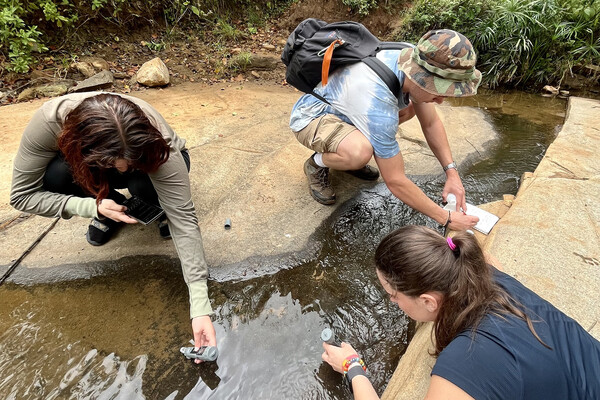
Griffin Pitt, right, works with two other student researchers to test the conductivity, total dissolved solids, salinity, and temperature of water below a sand dam in Kenya.
(Image: Courtesy of Griffin Pitt)
2 min. read

On any given day, the hundreds of students, faculty, and staff who circulate in Houston Hall are likely not paying attention to the same facets of the building that undergraduate students Wendy Hernandez Higarede and Veronica Baladi are.
They quietly wandered around one July morning, notebooks and air quality monitors in hand. They read the instructional infographics on the dual-compartment trash and recycling bins, expressing surprise at how many bins there were. They stopped at thermostats reading 73.5 and 70.5 degrees Fahrenheit. They noted the presence of water bottle filling machines and plants.
Then they headed to the Penn Museum. A week prior, they had spent time in Fagin Hall—home of the School of Nursing—making observations about stairwell ventilation, air quality, and signage.
Hernandez Higarede, Baladi, and Faith Amolo Owino were doing fieldwork as part of a project to identify climate and health education needs on campus. They participated in the Penn Undergraduate Research Mentoring Program (PURM), a 10-week summer research opportunity through the Center for Undergraduate Research and Fellowships that comes with a $5,000 award.
“We’re in the field looking at the lived experience of the environment and thinking about the educational opportunities related to climate and health,” says Penn Nursing professor Sarah Kagan, who leads Penn’s interdisciplinary Climate and Health Education Working Group. The other PURM project leaders are School of Veterinary Medicine professor Elizabeth Woodward and Heather Kostick, associate director of the Penn Center for Science, Sustainability, and the Media.
In addition to observing campus spaces and the people in them—such as how they’re talking about the weather and if they’re recycling, for example—students have been interviewing Penn community members and analyzing how Penn publications and websites cover climate and health. Their findings will be used to assess potential education and communication strategies and will be compared with Penn’s Climate and Sustainability Action Plan 4.0, among other resources, to identify alignment and gaps.
Baladi, a sociology and health and societies major from Fair Lawn, New Jersey, says the interviews have shown her that climate can intersect with a lot of areas people might not expect, whether that’s reducing waste in operating rooms or determining where to invest philanthropic funds. The rising third-year student says the project showed her there are different ways to do ethnography, and “it’s not necessarily one method fits all.”
“There is so much that goes into taking notes of things. I learned how to not be biased,” says Owino, a rising second-year student from Nairobi, Kenya. Owino says she chose to transfer to Penn because of the opportunities to do research and activities outside the classroom—an experience not available to her at her previous university in Kenya, which was focused on classes and grades. Kagen, her advisor in the Benjamin Franklin Scholars program, shared the research opportunity. As a nursing student with an interest in climate, Owino says this project was a good fit. Owino’s climate research focused on Penn’s College Houses.
Hernandez Higarede, a rising second-year nursing student from the Bronx, New York, and a Benjamin Franklin Scholar advised by Kagan, says she had no background in research but thought PURM would be a “cool opportunity.” Her interest in this project stemmed from the climate work she did in high school, including speaking to legislative aides about climate change and starting a gardening club.

Griffin Pitt, right, works with two other student researchers to test the conductivity, total dissolved solids, salinity, and temperature of water below a sand dam in Kenya.
(Image: Courtesy of Griffin Pitt)

Image: Andriy Onufriyenko via Getty Images

nocred

Provost John L. Jackson Jr.
nocred